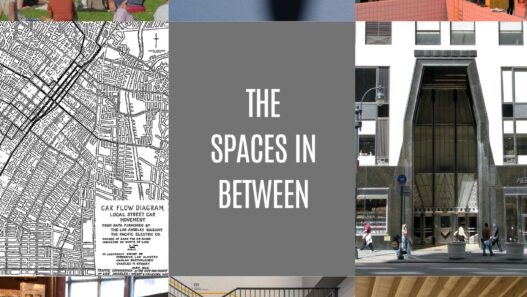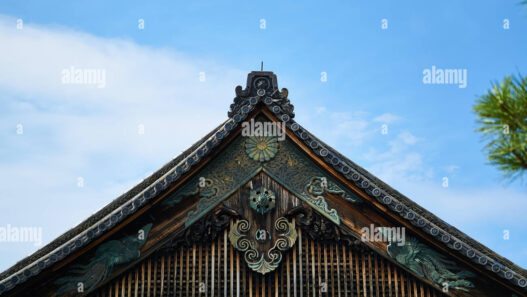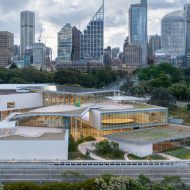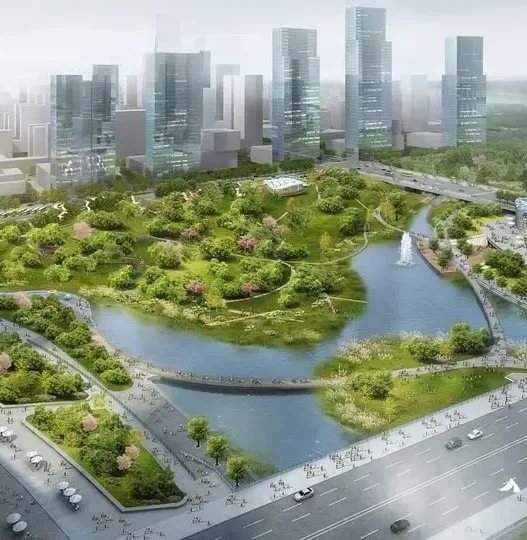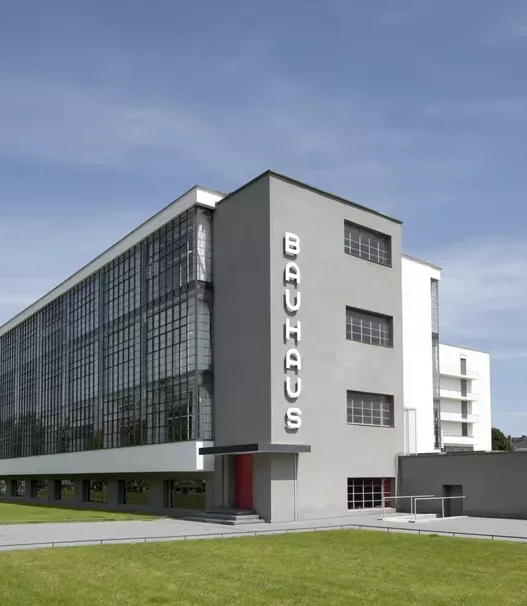Globalization has profoundly reshaped many aspects of our lives and architecture is no exception. Defined by the interconnection of economies, cultures and societies across the globe, this phenomenon has led to a dynamic exchange of ideas, styles and technologies in architecture. As cities develop and borders blur, architects find themselves inspired by a wide range of cultural influences, leading to innovative designs that reflect a rich tapestry of global heritage.

Definition of Globalization
In essence, globalization refers to the process by which businesses, cultures and economies become globally integrated and interdependent. In architecture, this means that local designs are increasingly infused with elements from various cultures, resulting in buildings that embody a mix of traditions and modern aesthetics. This cross-pollination of ideas creates spaces that resonate with diverse populations, fostering a sense of belonging and celebrating individuality at the same time.
Historical Context
Although the roots of globalization in architecture go back centuries, its acceleration began in the late 20th century with advances in technology, communication and transportation. The rise of multinational corporations and the internet enabled the rapid exchange of architectural knowledge and styles. Important movements such as Modernism in the early to mid-twentieth century demonstrated how Western architects began to embrace influences from non-Western cultures. This trend continued to flourish, especially in the post-colonial period, when many countries were trying to reclaim their identity while at the same time looking outward for inspiration.
Impact on Architectural Styles
The impact of globalization on architectural styles is both profound and multifaceted. Buildings today often blend traditional elements with contemporary design, reflecting both local cultural identities and global trends. Think of the striking skyscrapers in cities like Dubai, where Islamic architectural motifs coexist harmoniously with the latest technology and materials. This layering of styles not only creates visually striking structures, but also speaks to the communities that inhabit them, making architecture a canvas for shared narratives and experiences.
The Importance of Cross-Cultural Influences
Cross-cultural influences in architecture are vital for fostering dialogue and promoting mutual understanding between different traditions. They encourage architects to think beyond regional constraints, leading to innovative solutions that address global challenges such as sustainability and urbanization. For example, the integration of nature-inspired biophilic design principles is becoming increasingly popular worldwide. This approach not only improves the aesthetic quality of buildings, but also the well-being of their occupants, demonstrating how cross-cultural understandings can lead to healthier environments.
Case Study Overview
To better understand the effects of globalization on architecture, a few case studies are examined that demonstrate these principles in action. The Sydney Opera House stands as a testament to the blending of modernist design and local culture. Its iconic sail-like structure takes advantage of Australia’s seascape while showcasing innovative engineering. Similarly, the Louvre Abu Dhabi combines traditional Islamic architecture with a modern interpretation, creating a unique space that celebrates both heritage and contemporary art. These examples highlight how globalization has transformed architectural practice, resulting in spaces that are not only functional but also culturally rich.
As a result, globalization has opened up a world of possibilities for architects, allowing them to create spaces that reflect a fusion of ideas and cultural narratives. The ongoing dialogue between local traditions and global influences continues to shape the skyline of our cities, inviting us to discover and appreciate the different stories behind each building.
# Globalization and Architecture: A Comparative Study on Cross-Cultural Influences
Globalization has profoundly affected architecture, intertwining different cultural expressions and styles across the globe. As societies connect and interact, architecture emerges as a dynamic dialogue between tradition and modernity, local nuances and global trends. This research explores how various architectural styles have evolved under the influence of globalization, revealing a rich tapestry of cross-cultural exchanges.
Architectural Styles Shaped by Globalization
Modernism and its Global Spread
Modernism emerged in the late 19th and early 20th centuries as a revolutionary movement that sought to embrace new technologies and materials, resulting in a break with historic architectural styles. While modernist architects such as Le Corbusier and Ludwig Mies van der Rohe introduced principles of functionality and simplicity, their ideas crossed borders. This global diffusion was facilitated by advances in communication and transportation, allowing architects around the world to share and adapt modernist concepts.
From Tokyo to São Paulo, cities around the world began to adopt the clean lines and open spaces characteristic of modernism. In Brazil, for example, Oscar Niemeyer took modernist principles and blended them with local sensibilities to create iconic buildings such as the National Congress in Brasília. This blending of modernist ideals with regional identity illustrates the dialog between global and local influences and reveals how modernism became a platform for architectural innovation while respecting cultural heritage.
Postmodernism: A Global Perspective
Emerging in the late 20th century as a reaction to modernism, postmodernism was characterized by an eclectic mix of styles and a playful approach to architectural forms. It embraced historical references, ornamentation and irony, allowing architects to draw inspiration from different cultures and time periods. Important figures such as Robert Venturi and Michael Graves challenged the rigid tenets of modernism, encouraging a more inclusive architectural narrative.
The global nature of postmodernism is evident in buildings such as the Piazza d’Italia in New Orleans, where classical elements combine with contemporary design to reflect the rich cultural fabric of the city. Similarly, architects such as Arata Isozaki in Japan have used postmodern techniques to create buildings that reflect both local traditions and global design trends. This blending of influences not only enriched the architectural vocabulary, but also fostered a sense of identity that transcended geographical boundaries.
Regionalism and Local Responses
In response to the overwhelming impact of globalization, regionalism has emerged as a movement advocating architecture that reflects local context, culture and climate. It emphasizes the importance of place and encourages architects to utilize local materials and traditional building practices. This approach aims to create a sense of belonging and continuity in a rapidly changing world.
Examples of regionalism abound. In India, Charles Correa’s work integrates local materials and local forms to create spaces that resonate with the cultural identity of the region. Similarly, in Scandinavia, architects often prioritize sustainability and harmony with nature, creating designs that reflect the local environment. These regional responses demonstrate the resilience of local cultures in the face of globalization, ensuring that architecture remains a vital expression of community and identity.
Sustainable Architecture Across Cultures
As environmental concerns increase globally, sustainable architecture has gained importance across cultural boundaries. This movement reflects a common understanding of the need for ecological responsibility and encourages architects to explore innovative solutions that respect both the environment and local traditions. Sustainable design principles are now being integrated into architectural practice worldwide, influencing how buildings are designed and constructed.
In countries like Denmark, where sustainability is deeply embedded in design philosophy, architects are prioritizing energy efficiency and the use of renewable resources. In Ghana, meanwhile, local architects are embracing sustainable practices using earth-based materials and timeless traditional techniques. These examples show how sustainability transcends cultural contexts, honoring local practices while fostering a collective commitment to a healthier planet.
Neo-Eclectic Architecture Trends
The late 20th and early 21st centuries witnessed the rise of neo-eclectic architecture, characterized by the blending of various styles and influences. This trend often reflects the complexity of contemporary life, where cultural exchange is instantaneous and multifaceted. Neo-eclectic designs draw on historical references, modern aesthetics and global trends to create buildings as diverse as the communities they serve.
In the United States, for example, suburban developments often feature neo-eclectic homes that incorporate elements from different architectural styles, from Colonial to Mediterranean. This approach allows homeowners to express their individuality while participating in a broader architectural conversation. Similarly, in cities like Dubai, skyscrapers display a fusion of global architectural styles, creating a skyline that represents both local aspirations and international influences. This architectural melting pot reflects the interconnectedness of our globalized world, where each building tells a story of cultural change and innovation.
As a result, globalization has transformed architecture into a vast field of experimentation and dialogue. From the global reach of modernism to regionalism’s emphasis on local identity, each architectural style embodies a complex interplay of cultural influences. As we continue to navigate a rapidly changing world, understanding these dynamics will be crucial to shaping the future of architecture and ensuring that it remains a true reflection of diverse human experiences.
# Globalization and Architecture: A Comparative Study on Cross-Cultural Influences
Case Studies on Iconic Buildings
Architecture is a powerful reflection of culture, history and innovation. As globalization connects different societies, it also influences architectural styles and practices across the globe. This section examines several iconic structures that embody these cross-cultural influences, showing how they represent not only their local context but also a broader global narrative.
Burj Khalifa: A Global Icon
Standing majestically in Dubai, the Burj Khalifa is not only the tallest building in the world; it is also a symbol of modern ambition and engineering prowess. Completed in 2010, this towering structure reaches a height of many meters and has become a global icon. Designed by renowned architect Adrian Smith of Skidmore, Owings & Merrill, it draws inspiration from traditional Islamic architecture, particularly the minaret, while adopting modern engineering techniques.
Burj Khalifa’s influence extends beyond its physical presence. It represents Dubai’s rapid transformation from a modest trading port to a global metropolis and demonstrates how architecture can express the aspirations of a city. The building has become a focal point for tourism and a symbol of luxury, attracting millions of visitors. Observation decks offer breathtaking views, reinforcing the idea that architecture can create communal experiences and connect people across cultures.
Sydney Opera House: Cultural Synthesis
The Sydney Opera House is a masterpiece of modern architecture and a symbol of Australia’s cultural identity. Designed by Danish architect Jørn Utzon, its unique sail-like structure has captured the imagination of people around the world since its completion in 1973. The building not only serves as a venue for the performing arts, but also represents a fusion of artistic expression and engineering innovation.
Utzon’s design was influenced by various cultural elements, including Australia’s indigenous heritage. The building’s location on Bennelong Point offers a stunning view of Sydney Harbor and reinforces its connection to the landscape. The Sydney Opera House is a testament to how architecture can synthesize different cultural influences, creating a space that resonates with both local and global audiences. Its iconic status has placed it on the UNESCO World Heritage list, highlighting the importance of cultural landmarks in a globalizing world.
Tate Modern: Industrial Transformation
Housed in a former power station on the banks of the River Thames in London, Tate Modern is a prime example of how industrial buildings can be transformed into cultural institutions. Designed by architects Herzog & de Meuron, it opened in London and quickly became one of the most visited contemporary art museums in the world.
Tate Modern exemplifies the theme of adaptive reuse in architecture, where old buildings are transformed to meet new functions. The conversion of Bankside Power Station into a modern art museum symbolizes the transition from an industrial to a cultural economy in urban areas. The museum’s large, open galleries allow for the display of large-scale installations and works by renowned artists, creating a dialog between old and new. This blending of history and modernity reflects the global trend of redesigning urban spaces and making art accessible to diverse audiences.
Guggenheim Bilbao Urban Transformation
The Guggenheim Museum in Bilbao, Spain is often hailed as a catalyst for urban transformation. Designed by Frank Gehry and opened in Bilbao, the museum’s innovative, sculptural design has had a profound impact on the city’s cultural landscape. The building’s fluid forms and titanium cladding embody the spirit of contemporary creativity, challenging traditional architectural norms.
The Guggenheim Bilbao is a striking example of how a single architectural project can revitalize an entire district. Before the construction of the museum, Bilbao was facing economic decline and industrial stagnation. The opening of the Guggenheim attracted tourists, revitalized local businesses and inspired a wave of urban development. This transformation demonstrates the potential of architecture to facilitate economic and social regeneration, showing how global influences can reshape local identities.
National Museum of African American History and Culture
Located on the National Mall in Washington, D.C., the National Museum of African American History and Culture is an important addition to the Smithsonian Institution. Designed by David Adjaye and opened its doors in 2016, the museum offers a space dedicated to preserving and celebrating African American history and culture.
The museum’s design is highly symbolic, inspired by the traditional Yoruban caryatid, reflecting the African heritage of African Americans. The building’s three-tiered design, resembling a corona, serves to honor the complexity of the African American experience. The museum not only provides a platform for education and reflection, but also embodies the ongoing dialogue between history and contemporary society.
Through its exhibitions and programs, the Museum promotes an understanding of the African American narrative within the larger context of American history. The Museum is a testament to how architecture can be used as a vehicle for cultural expression, bridging gaps between communities and fostering a sense of shared history in a globalized world.
Ultimately, these iconic buildings exemplify the complex relationship between globalization and architecture. Each building tells a unique story, reflecting local cultural influences while also participating in a broader global narrative. As we explore these architectural wonders, we gain insight into how they have shaped our understanding of identity, community and the ever-evolving urban landscape.
# Globalization and Architecture: A Comparative Study on Cross-Cultural Influences
The Role of Technology in Architectural Globalization
As the world becomes increasingly interconnected, technology is playing an important role in shaping architectural practices across cultures. This influence is seen in various aspects, from the materials used in construction to the design and collaboration processes. Understanding how technology facilitates architectural globalization reveals not only the evolution of structures, but also the blending of cultural identities in our built environment.
Advances in Building Materials
The evolution of building materials is one of the cornerstones of modern architecture. Innovations such as high-strength concrete, sustainable timber and advanced composites have changed the way architects approach design. Not only are these materials stronger and more durable, they are also increasingly environmentally friendly, allowing architects to address environmental concerns while meeting global standards.
For example, the use of cross-laminated timber (CLT) has gained popularity worldwide, allowing for taller timber structures that challenge the traditional concept of timber as a low-rise material. This progression reflects the convergence of practices from various cultures that value sustainability, such as Scandinavian designs that harmonize with nature. As architects incorporate these materials, they facilitate a dialog between local traditions and modern techniques, creating a new identity in the architectural landscape.
Digital Design and Global Collaboration
The rise of digital design tools has revolutionized the way architects conceptualize and execute their projects. Software such as Building Information Modeling (BIM) allows architects from different parts of the world to collaborate in real time, breaking down geographical barriers. This collaborative spirit not only boosts creativity, but also allows different cultural perspectives to be integrated into the design process.
For example, an architect in Japan can work seamlessly with a team in Brazil through shared digital platforms, allowing for a fusion of styles and methodologies. This cross-cultural exchange enriches design, resulting in buildings that embody a global sensibility while respecting local contexts. Moreover, the accessibility of digital tools has democratized architecture and enabled new architects from diverse backgrounds to contribute to the global debate.
The Impact of Social Media
In today’s world, social media has a strong influence in shaping architectural trends and styles. Platforms such as Instagram and Pinterest allow architects to showcase their work to a global audience, receiving instant feedback and inspiration from colleagues and enthusiasts alike. This visibility can lead to trends that cross borders, allowing innovative ideas to spread rapidly.
Architects are often inspired by different cultures and share their own interpretations through social media. This exchange creates a melting pot of ideas where traditional elements of one culture can be reimagined in another context. For example, a traditional Moroccan pattern can inspire the contemporary facade of a skyscraper in New York, demonstrating how social media acts as a catalyst for cross-cultural influences in architecture.
Virtual Reality in Architectural Visualization
Virtual reality (VR) is emerging as a transformative tool in architectural visualization, offering immersive experiences that allow stakeholders to interact with designs before they are built. The technology enables architects to create lifelike representations of their projects, making it easier to better communicate with clients and communities.
Imagine walking through a virtual model of a new urban development, experiencing the space as if it had been built. This technology not only improves the design process, but also encourages a more inclusive approach to architectural planning by inviting input from a wider audience. By incorporating feedback from different cultural perspectives, architects can create spaces that resonate with the wider community and ensure that the final product is both functional and culturally appropriate.
Smart Cities and Global Trends
The concept of smart cities is another important trend influenced by globalization and technology. These cities utilize advanced technologies to improve infrastructure, enhance sustainability and improve the quality of life of residents. They often take inspiration from successful models from around the world and adapt features to suit local needs.
For example, cities like Singapore and Barcelona have been pioneers in smart technology, integrating data analytics and IoT devices to efficiently manage resources. Architects involved in these projects must consider not only the physical design of buildings, but also how they interact with their surroundings and society. This holistic approach reflects a global trend towards creating urban spaces that respond to the needs of diverse populations, ultimately leading to more livable and sustainable cities.
As a result, technology is acting as a bridge in the field of architectural globalization, facilitating a dynamic exchange of ideas and practices. As architects embrace advances in materials, design, collaboration and visualization, they are creating spaces that reflect a rich tapestry of cultural influences and ultimately shape the future of our built environment.
# Globalization and Architecture: A Comparative Study on Cross-Cultural Influences
Cultural Challenges and Ethical Considerations
As the world becomes more interconnected, the field of architecture faces a unique set of cultural challenges and ethical considerations. Globalization has enabled the free exchange of ideas, materials and designs, but it has also raised questions about authenticity, heritage preservation and the social impact of architectural projects. In this section, we will explore these challenges in depth, examining how they shape the architectural landscape and impact the communities they serve.
Authenticity and Appropriation
In a globalized architectural environment, the line between inspiration and appropriation can often be blurred. By drawing on different cultural motifs and styles, architects can create innovative designs that celebrate global heritage. But this practice can also lead to accusations of cultural appropriation, where elements of a culture are used without permission or understanding, often stripping them of their original significance.
Consider, for example, the use of traditional motifs in modern buildings. While these designs can honor their origins, they can also come across as superficial or exploitative if not applied with sensitivity. Architects must strike this delicate balance by ensuring that their work respects and recognizes the cultures from which they draw inspiration. This requires a deep understanding of cultural contexts and a continuous dialog with local communities to ensure that architectural practices are both innovative and respectful.
Preserving Local Heritage
As cities expand and modernize, the preservation of local heritage becomes increasingly critical. Architecture is not just about constructing new buildings; it is also about preserving the stories and identities embedded in existing structures. Globalization can often lead to the homogenization of urban landscapes where local styles and historical contexts are overshadowed by universal designs.
A notable example is the preservation efforts in cities such as Kyoto, Japan. Here, strict regulations preserve traditional wooden houses and temples, allowing the city to maintain its cultural identity amidst the pressures of modernization. Such efforts emphasize the importance of integrating modern needs with historic contexts and remind architects of their role as custodians of cultural heritage. By embracing local materials and craftsmanship, architects can create spaces that honor history while serving contemporary needs.
Impact of Global Standards
The rise of global standards in architecture has brought about significant changes in the way buildings are designed and constructed. On the one hand, these standards promote safety, efficiency and sustainability. On the other hand, they can lead to the loss of local architectural identity. Buildings designed in accordance with international rules, prioritizing functionality over cultural expression, can create structures that could exist anywhere in the world.
For example, the proliferation of glass and steel skyscrapers exemplifies this trend. While symbolizing the Study of Intercultural Influences
Cultural Challenges and Ethical Considerations
In our increasingly interconnected world, the field of architecture faces significant challenges and ethical dilemmas, especially as it grapples with the effects of globalization. Architects and designers must strike a delicate balance between celebrating diversity and respecting cultural integrity while drawing inspiration from diverse cultures. This chapter addresses complex issues such as authenticity versus appropriation, the preservation of local heritage, the impact of global standards, the consequences of gentrification, and the ethical responsibilities of architects.
Authenticity and Appropriation
The concept of authenticity in architecture is deeply tied to a culture’s identity. As global influences permeate local practices, the line between authentic representation and cultural appropriation is often blurred. Authenticity expresses a true expression of cultural identity, while appropriation can diminish this identity by removing elements without understanding their significance. For example, when designers incorporate local motifs into their work without interacting with the communities they represent, it can lead to a superficial practice that removes cultural meaning. The use of African tribal patterns in Western fashion is a notable example, often lacking cultural context and significance, leading to debates about respect and appropriation.
The challenge lies in ensuring that architectural expressions honor their cultural origins. Engaging with local communities, understanding their stories and incorporating their voices into the design process can help bridge this gap. Successful projects often emerge from collaborative efforts that respect and celebrate local traditions while encouraging innovation.
Preserving Local Heritage
As cities develop, the preservation of local heritage becomes increasingly critical. Architectural heritage reflects a community’s history, values and identity. Globalization can threaten this heritage, as modern developments often favor economic growth over cultural preservation. For example, in cities such as Istanbul and Cairo, historic neighborhoods are at risk of being overshadowed by soaring skyscrapers and commercial developments.
Efforts to preserve local heritage can take various forms. Adaptive reuse is a strategy where old buildings are repurposed for new functions while preserving their historic integrity. This approach not only preserves the physical structure, but also the stories and memories associated with it. The transformation of warehouses into art galleries or lofts in cities such as New York exemplifies how heritage can be integrated into contemporary life and how communities can maintain connections to their past.
Impact of Global Standards
Global standards in architecture, such as sustainability certifications and building codes, aim to ensure quality and safety. However, these standards can sometimes ignore local contexts, leading to inappropriate or culturally inappropriate designs. For example, a building designed to meet international energy efficiency standards in a temperate climate may not take into account the unique environmental conditions of a tropical region.
To address this problem, architects must adapt global standards to fit local contexts. This adaptation requires a deep understanding of regional climates, materials and cultural practices. A successful example of this is the use of local building materials and techniques that not only meet global standards, but are also in line with local aesthetics and traditions. By combining international best practices with local knowledge, architects can create spaces that are both functional and culturally relevant.
Gentrification and Community Displacement
Gentrification is a complex phenomenon that often accompanies urban development. It typically involves the transformation of neighborhoods with an influx of wealthier residents, which can lead to rising property values and the displacement of long-standing communities. This process raises ethical questions for architects: how can they design for growth without displacing those who have historically lived in these neighborhoods?
Architects play a crucial role in addressing gentrification by advocating for inclusive design practices. Projects that prioritize affordable housing, community spaces and local businesses can help mitigate the negative impacts of gentrification. For example, community land trusts provide a model for preserving affordable housing and preventing displacement by enabling communities to collectively own and manage their land.
Ethical Responsibilities of Architects
As architects navigate the complexities of globalization, they must also embrace their ethical responsibilities. This includes not only creating aesthetically pleasing buildings, but also considering the social, cultural and environmental impact of their work. Architects have the power to shape societies and influence the quality of life of their residents. Therefore, their designs should reflect a commitment to inclusivity, sustainability and cultural sensitivity.
Ethical architecture emphasizes collaboration, transparency and respect for local communities. Architects should engage with stakeholders throughout the design process, ensuring that their voices are heard and their needs are met. This collaborative approach fosters trust and encourages designs that truly reflect the essence of society.
In conclusion, the interaction between globalization and architecture presents both challenges and opportunities. By addressing issues of authenticity, heritage preservation, global standards, gentrification and ethical responsibility, architects can create spaces that honor cultural diversity while fostering innovation. As we move forward in a globalizing world, the role of architecture in shaping our environment and societies becomes even more vital.
# Globalization and Architecture: A Comparative Study on Cross-Cultural Influences
Future Directions in Global Architecture
As we stand on the threshold of a new architectural era, it is increasingly vital to explore the directions global architecture can take in the future. The interplay of cultures, technologies and environmental factors is shaping not only how buildings are designed, but also how they function in the societies in which they are located. The future of architecture is not just about aesthetics; it is about creating spaces that respond to global challenges and local needs.
Emerging Architectural Trends
Architecture in today’s world is evolving rapidly, influenced by technological advances and societal changes. One prominent trend is the rise of sustainable design, where architects are prioritizing environmentally friendly materials and energy-efficient systems. Green roofs, solar panels and rainwater harvesting systems are becoming key elements of new construction, reflecting a growing awareness of our environmental impact. In addition, biophilic design, which integrates natural elements into buildings, is gaining traction as people seek a deeper connection with nature in urban environments. This trend not only enhances the aesthetic appeal of buildings, but also improves the well-being of their occupants.
Another emerging trend is the use of digital technologies in architecture. With tools such as 3D printing and virtual reality, architects can visualize and create their designs more efficiently than ever before. These technologies allow for customization and experimentation, enabling innovative forms and structures that were previously unimaginable. As digital fabrication becomes more mainstream, we can expect to see a shift away from traditional building methods towards more adaptive and responsive architectural practices.
The Role of Climate Change
Climate change is undoubtedly one of the most pressing issues of our time and its implications for architecture are profound. Architects are being asked to design buildings that not only withstand extreme weather events but also contribute to climate resilience. This requires rethinking materials, construction techniques and site selection. For example, in coastal cities facing sea level rise, architects are exploring floating structures and elevated designs to reduce flood risks.
Climate-responsive architecture is also gaining momentum. This approach emphasizes the importance of local climatic conditions in the design process, ensuring that buildings are optimized for energy efficiency and occupant comfort. Passive solar design, for example, utilizes sunlight for heating and lighting, reducing reliance on artificial energy sources. By addressing the realities of climate change, architects can create sustainable spaces that serve both people and planet.
Globalization and Localization
The tension between globalization and localization is a critical theme in contemporary architecture. Globalization has facilitated the cross-border exchange of ideas and architectural styles, leading to the hybridization of design practices. Iconic skyscrapers and modernist structures can be found in cities around the world, each reflecting a mix of international influences. But this trend can sometimes overshadow local traditions and cultural identity.
On the other hand, localization emphasizes the importance of context, heritage and community in architectural design. Architects increasingly recognize the value of integrating local materials, techniques and cultural narratives into their work. For example, in regions with rich architectural histories, contemporary buildings that respect traditional styles can foster a sense of place and continuity. The challenge lies in finding a balance that honors local contexts while embracing the benefits of global cooperation.
Innovations in Urban Planning
The future of architecture is intricately linked to innovations in urban planning. As cities continue to grow and evolve, planners and architects are reimagining how urban spaces can be more livable, inclusive and sustainable. Concepts such as smart cities, where technology is used to improve urban infrastructure and services, are gaining traction. This includes everything from traffic management systems to energy-efficient public transportation options.
In addition, urban areas are increasingly focused on mixed-use developments that combine residential, commercial and recreational space. This approach not only improves accessibility, but also encourages social interaction and economic vitality. For example, neighborhoods designed around walkability and green spaces encourage social inclusion and support healthier lifestyles. As urban planning becomes more integrated with architecture, the possibilities for creating vibrant and resilient cities are expanding.
The Future of Intercultural Collaborations
Cross-cultural collaborations are at the heart of the future of architecture. As architects from different backgrounds come together, they bring unique perspectives and solutions to the challenges facing societies around the world. These collaborations often lead to innovative designs that reflect a mix of cultural influences, resulting in spaces that deeply resonate with their users.
For example, recent projects have seen architects from different countries working together to address issues such as housing shortages in developing regions. By sharing knowledge and resources, these teams are able to create sustainable solutions tailored to local needs. The exchange of ideas not only enriches the architectural landscape, but also fosters mutual understanding and respect between cultures.
As a result, the future of global architecture is shaped by exciting trends, urgent challenges and invaluable collaborations. As architects navigate the complexity of our interconnected world, they have the opportunity to shape spaces that are not only functional, but also reflect our diverse cultural heritage and our shared responsibility towards a sustainable future.
Discover more from Dök Architecture
Subscribe to get the latest posts sent to your email.



